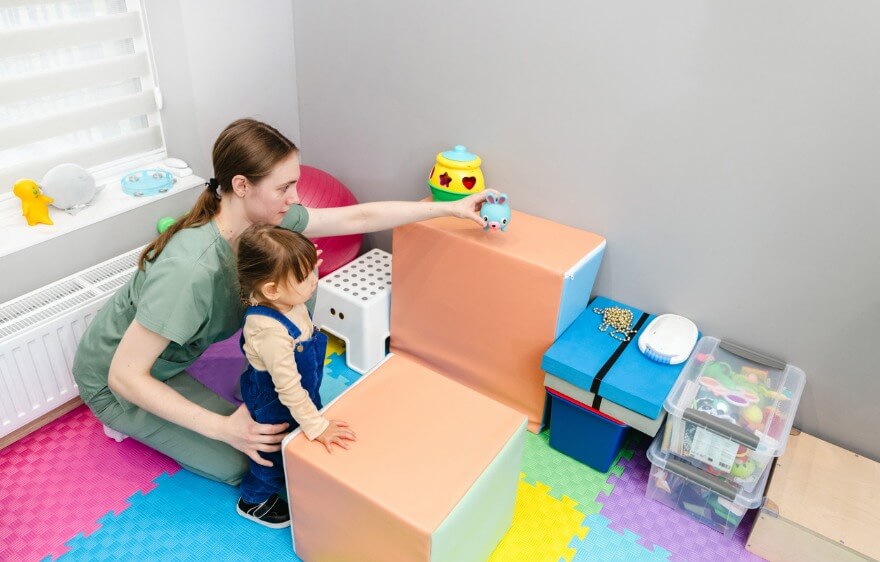For pediatric physical therapists, a big part of the job is helping children and families reach those precious milestones — rolling over, sitting up, walking, and running. And in situations where things aren’t progressing quite as expected, early intervention physical therapy (PT) can be a huge help!
Early intervention in physical therapy is designed to help children who are struggling to develop physically, whether it’s due to a developmental delay, injury, or congenital condition. With the right support at the right time, children can overcome obstacles and build the skills they need for a happy, healthy future.
That’s why we’re taking a close look at early intervention physical therapy, including why it is so important, when it’s needed, and the specific goals you can set as a PT to help children and parents reach key developmental milestones. Ready? Let’s dive in!
What Is Early Intervention Physical Therapy?
Early intervention physical therapy refers to specialized therapeutic services aimed at helping children under the age of three who have delays in motor skills development or physical disabilities. These therapies focus on a kiddo’s ability to move and interact with the world around them. Physical therapists work closely with families, children, and other healthcare professionals to create a customized plan that addresses the child’s unique needs.
Children go through various physical and developmental milestones as they grow, like sitting up, standing, and walking. If a child is delayed in any of these areas, early intervention physical therapy may be the solution. The goal is to provide therapeutic services before the age of three to support the child’s overall development and to prevent future challenges as they grow older.
Physical therapy for young children often incorporates fun and engaging activities, which are designed to help them build strength, coordination, balance, and motor skills while ensuring that therapy feels like play. The earlier these skills are addressed, the better chance a child has of reaching their full potential.
Why Is Early Intervention Physical Therapy So Important?
Early intervention physical therapy is a game-changer in the world of child development. There are several reasons why it is so important for both the child and the family. Here are a few key points to consider:
Brain Development Is at Its Peak in Early Years
Children’s brains are highly adaptable and can make significant strides in the first few years of life. By targeting developmental delays early, physical therapy can help the brain form the right connections for proper motor skills development. Intervening early in a child’s life provides the best opportunity to help them reach key physical milestones and lay the groundwork for cognitive and social development.
Early Intervention Prevents Future Challenges
Without the support of early intervention physical therapy, small delays or problems can develop into bigger challenges down the road. A child who struggles with balance and coordination, for example, may have trouble with activities that require physical agility, like sports or simply running around with friends. By addressing these issues early, physical therapy helps prevent long-term struggles that can affect the child’s self-esteem and future independence.
Early Intervention Improves Long-Term Outcomes
When a child receives early intervention physical therapy, they are more likely to achieve better long-term outcomes. Whether they are dealing with cerebral palsy, a developmental delay, or a motor skill issue, starting therapy early significantly improves the chances of success. It allows children to develop more natural movement patterns and avoid compensating in ways that could lead to other issues later.
It Empowers Parents and Caregivers
Early intervention also empowers parents. When parents see the progress their child is making, it builds confidence in their ability to help their child succeed. PTs not only work with children but also teach parents strategies and exercises they can do at home to further support their child’s development.
It’s Cost-Effective in the Long Run
Addressing developmental issues early on may prevent the need for more intensive treatments or interventions in the future. Early intervention physical therapy can help reduce long-term healthcare costs by preventing the development of secondary conditions that would require more complex medical interventions.
When Do Clients Need Early Intervention Physical Therapy?
Recognizing when a child needs early intervention physical therapy can be tricky. Sometimes, delays in development are subtle and hard to spot, but any of the following signs can mean that early intervention physical therapy may be the right approach:
Delays in Reaching Physical Milestones
Every child develops at their own pace, but if a child isn’t meeting key milestones like rolling over, crawling, or walking when expected, it may be time to seek help. Physical therapists can evaluate a child’s movement patterns and provide early intervention to help them catch up.
Difficulty with Balance or Coordination
If a child is consistently falling, tripping, or has difficulty standing or walking, this could be a sign of a delay in motor skill development. Early intervention physical therapy can provide exercises and techniques to help improve balance and coordination.
Stiff or Weak Muscles
A child with excessively stiff muscles or one who seems weak and floppy may need physical therapy to strengthen muscles and improve flexibility. PTs can help children develop the strength and movement needed for everyday activities.
Limited Range of Motion
If a child struggles to move their arms, legs, or neck in ways that other children of the same age can, physical therapy may be required to help with mobility and flexibility. Early intervention can help improve joint flexibility and prevent further complications as the child grows.
Abnormal Postures or Movements
Children who frequently adopt unusual postures or engage in abnormal movements may benefit from early intervention physical therapy. A physical therapist can assess whether these movements are related to a developmental issue or a motor dysfunction that requires specific therapy.
If any of these signs are present, it’s important to reach out to a healthcare provider who can refer the child for an assessment. Early intervention physical therapy can make all the difference when it comes to helping children reach their full potential.
Early Intervention Physical Therapy Goals
Once a child has been referred for early intervention physical therapy, physical therapists work closely with families to set specific goals that are tailored to each little one’s needs. These goals are typically designed to target motor development, strength, coordination, balance, and overall physical function.
Here are some common early intervention physical therapy goals you can use as a therapist to help children achieve important milestones:
1. Increase Strength and Muscle Tone
One of the most important goals of early intervention physical therapy is to help children develop the strength they need to perform everyday tasks. Whether it’s rolling over, sitting, or walking, increasing muscle strength is essential. PTs can design exercises to build core strength, leg strength, and overall muscle tone.
2. Improve Balance and Coordination
Many children with developmental delays struggle with balance and coordination. A common early intervention physical therapy goal is to help improve these skills so that children can perform tasks like standing, walking, and even running with greater ease. Simple balance exercises, such as standing on one foot or walking along a line, can help develop these skills over time.
3. Promote Range of Motion
Range of motion is key to a child’s mobility. If a child is experiencing stiffness or limited flexibility, early intervention physical therapy can help improve their range of motion in the joints. This allows them to move more freely and perform everyday activities like playing and reaching for objects.
4. Enhance Posture and Body Awareness
Children need to develop proper posture to engage in activities like sitting at a table, walking, and playing. Early intervention physical therapy helps children develop awareness of how their bodies move and position themselves, leading to improved posture and overall body control.
5. Achieve Age-Appropriate Motor Milestones
Every child has different developmental timelines, but there are age-appropriate motor milestones that most children reach. Physical therapy can help children hit these milestones – from sitting up to walking and jumping. By targeting specific developmental delays, therapists work with children to achieve these milestones as quickly as possible.
6. Facilitate Self-Help and Daily Activities
For children with more severe developmental delays, early intervention physical therapy can help them develop skills needed for daily living. Tasks like dressing, feeding themselves, and toileting can be supported through tailored physical therapy interventions that focus on gross motor skills and fine motor skills.
7. Support Family Involvement
Another important goal of early intervention physical therapy is to involve the family in the child’s progress. Physical therapists will work with parents to ensure they are comfortable and confident in carrying out therapy activities at home. This helps reinforce the child’s progress and encourages family support in the long term.
Proactive Therapy in Action
Early intervention physical therapy is an essential part of helping children develop the motor skills they need to thrive. By addressing delays early on, children are given the opportunity to reach their full potential, avoid long-term struggles, and gain the strength and coordination they need for a successful future. Whether the goal is to achieve basic milestones like crawling or more complex tasks like walking and jumping, early intervention physical therapy plays a crucial role in setting children up for a lifetime of success.
The sooner a child receives the support they need, the better their chances are for growth and success. Early intervention physical therapy is about more than addressing challenges — it’s about setting children on the path to a bright, active, and joyful future.
For everyone involved, physical therapy should be a journey built on dedication, understanding, and compassion. At Care Options for Kids, we are dedicated to ensuring therapists have the resources, training, and support necessary to guide each child and family toward their developmental goals. In a team-oriented atmosphere, our therapists can offer personalized care that addresses everyone’s needs. We’re proud to offer a community that delivers outstanding physical therapy outcomes along with great benefits and flexibility.
Join the Care Options for Kids Team!
Are you ready for meaningful work that comes with benefits and not burnout? Join the compassionate care team that helps children and families live their best lives. Our clinicians provide best-in-class pediatric nursing, therapy, and school-based services. We bring individualized care to children where they live, work, and play. We have opportunities in homes, schools, and clinics across the country.
Apply at Care Options for Kids now. We make it easy to start so you can make a difference as soon as possible.






